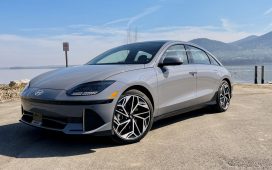All new vehicles will be required to have a “more effective” version of automatic emergency braking (AEB) under a new rule proposed today by the US Department of Transportation.
Around 90 percent of light-duty vehicles on the road today come standard with AEB. But the Department of Transportation is proposing a rule that would require automakers to adopt a more robust version of the technology that can stop vehicles traveling at higher speeds and detect vulnerable road users, like cyclists and pedestrians, even at night.
However, NHTSA is not proposing to “use a bicycle test device during testing,” raising questions around the agency’s commitment to protecting cyclists. NHTSA said it is continuing to conduct crash tests using bicycle and motorcycle “surrogates,” and expects to release its findings at the end of the year.
“AEB systems are a big step forward for saving lives on our roadways and preventing crashes,” US DOT Deputy Secretary Polly Trottenberg said at a press conference Wednesday. “When deployed, AEB systems can potentially bring a vehicle to a complete halt or at least slow them down so that there’s significantly less damage on impact.”
“AEB systems are a big step forward for saving lives on our roadways and preventing crashes”
In 2015, a majority of automakers made a voluntary commitment to include AEB as standard in all new vehicles. The Insurance Institute for Highway Safety estimates that AEB, which uses forward-facing cameras and other sensors to automatically apply the brakes when a crash is imminent, would help prevent 28,000 crashes and 12,000 injuries by 2025.
But now, the Department of Transportation and the National Highway Traffic Safety Administration (NHTSA) are ready to go beyond voluntary commitments, proposing a rule that would make AEB mandatory in all new vehicles within four years of the rule going into effect.
Around 65 percent of new vehicles sold today meet testing procedures for the government’s five-star safety rating, also known as the New Car Assessment Program, or NCAP, according to NHTSA chief counsel Ann Carlson. “The technology now is mature enough for us to propose mandating its inclusion in all vehicles,” Carlson added, “but we’re doing a whole lot more than that.”
AEB will be required to be “much more effective at much higher speeds,” she said. Vehicles traveling as fast as 37mph will need to come to a complete stop to avoid hitting pedestrians under the proposal. AEB systems will also be required to detect pedestrians and cyclists at night — something many current systems often fail to do. The rule also includes a provision for “full collision avoidance” in which a vehicle needs to stop without touching the vehicle in front of it.
AEB will be required to be “much more effective at much higher speeds”
“The test is very tough to meet,” Carlson said. “And the reason it’s tough to meet is to eliminate as many collisions as possible.”
Research has shown that current AEB systems are decent at preventing low-speed rear-end crashes but kind of suck when vehicles are traveling at fast but still average speeds. The American Automobile Association (AAA) has been testing AEB systems for years and found a variety of common scenarios in which the braking technology completely fails to do the job as advertised.
T-bones and left-turn collisions, which account for around 40 percent of fatal crashes, are still almost impossible to prevent using AEB. Likewise, many AEB systems are crap at stopping vehicles from running over children, and at night, many of them are basically worthless.
More than 70 percent of pedestrian fatalities occur at night, according to NHTSA. So the need for better detection systems in darkened conditions is paramount. “Our proposed rule will directly address this problem, saving countless lives in doing so,” Carlson said.
The announcement came at a time when pedestrian deaths on the roads are still disturbingly high. Drivers in the US struck and killed 3,434 people in the first half of 2022 – up 5 percent from the same period the year before, according to a new analysis from the Governors Highway Safety Association. The projection follows a year in which pedestrian deaths hit a 40-year high. NHTSA estimates that around 23,000 pedestrian injuries recorded from 2016 to 2019 could have been prevented if this rule has been in place.
More stringent testing around AEB is sure to ruffle some feathers in the auto industry, but Trottenberg said she’s confident that automakers can rise to the challenge.
“To our industry colleagues, we know we’re throwing a challenge out here, but we know that a lot of this technology is already pretty well developed,” she said. “And this is a time to take things to the next level, to make this technology more universally deployed and more stringent for our fellows in the auto industry.”
Update May 31st, 2:40PM ET: Updated to clarify that bicycles are not being used as part of NHTSA’s AEB testing.












